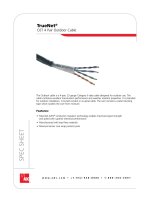Tài liệu Lock-and-Key pdf
Bạn đang xem bản rút gọn của tài liệu. Xem và tải ngay bản đầy đủ của tài liệu tại đây (23.74 KB, 3 trang )
1 - 3 Semester 5: Advanced Routing v2.0 - Lab 10.7.1 Copyright 2001, Cisco Systems, Inc.
10.7.1 Lock-and-Key
S0/0
192.168.1.1 /24
S0/0
192.168.1.2 /24
Host A
10.0.0.11 /8
SanJose1
Fa0/0
10.0.0.1 /8
Vista
Host B
192.168.3.2 /24
Fa0/0
192.168.3.1 /24
Objective
In this lab, you configure a dynamic access list for lock-and-key security.
Scenario
International Travel Agency (ITA) maintains a secure network (10.0.0.0/8) behind
SanJose1, which acts as a firewall. You have been transferred to a remote site in the
company (192.168.3.0/24) that is not permitted through SanJose1’s firewall. The
company allows you to modify SanJose1’s access list so that you, and you alone, can
access the secured resources. Because you work at various stations at the remote site,
you decide to configure lock-and-key so that you can get access from any IP address.
Step 1
Build and configure the network according to the diagram; use IGRP as the routing
protocol. Be sure to enter the correct network statements.
Use ping and show ip route to test connectivity among all interfaces. Each router
should have a complete routing table.
Step 2
Configure lock-and-key on SanJose1. You can assume that SanJose1 has a
comprehensive access list set on Serial 0/0. But for the purposes of this lab, you need to
configure only the portions of the list relevant to lock-and-key.
2 - 3 Semester 5: Advanced Routing v2.0 - Lab 10.7.1 Copyright 2001, Cisco Systems, Inc.
Because you expect to Telnet to SanJose1 to authenticate, you must permit Telnet
access from your remote network. Also, SanJose1 will need to exchange routing updates
with Vista, so you must be sure to permit IGRP. Enter the following commands on
SanJose1:
SanJose1(config)#access-list 101 permit tcp 192.168.3.0 0.0.0.255
host 192.168.1.2 eq telnet
SanJose1(config)#access-list 101 permit igrp any any
SanJose1(config)#access-list 101 dynamic LETMEIN timeout 90 permit
ip 192.168.3.0 0.0.0.255 10.0.0.0 0.255.255.255
SanJose1(config)#username ernie password bert
SanJose1(config)#interface serial 0/0
SanJose1(config-if)#ip access-group 101 in
SanJose1(config-if)#line vty 0 4
SanJose1(config-line)#login local
SanJose1(config-line)#autocommand access-enable host timeout 2
Note that the dynamic access list statement contains the option timeout 90, which
places an absolute limit on the amount of time that the temporary hole in the firewall can
exist. After 90 minutes, you have to authenticate again, even if you’ve kept the
connection busy with traffic.
The autocommand configuration is used to automate the process of creating a
temporary access list entry. Upon authentication, SanJose1 executes the access-
enable command and creates a temporary entry for your individual IP address. The
host keyword prevents this temporary entry from including other members of your
subnet. Finally, the timeout 2 option configures the idle timeout to 2 minutes. If your
connection is idle for more than two minutes, you have to authenticate again.
Step 3
Verify that the access list is working. From Host B, attempt to ping Host A, which is on the
secure network. The ping to 10.0.0.11 should fail. If it doesn’t, troubleshoot your access
list.
When you have confirmed that the firewall on SanJose1 is preventing you from reaching
10.0.0.11, you can test the lock-and-key configuration.
From Host B, Telnet to SanJose1’s Serial 0/0 (192.168.1.2). You are prompted to
authenticate with a username and password. Enter the correct login information.
1. If SanJose1 is configured properly, you should be logged out of the Telnet session
immediately. Why?
Again, from Host B, repeat your ping to 10.0.0.11. This ping should be successful.
2. If you don’t send any more traffic, how much longer will this hole in the firewall exist?
3. Can other nodes on your subnet use this temporary hole? Why or why not?
Issue the show ip access-lists command on SanJose1.
4. What indications do you see that lock-and-key has been successfully configured?
3 - 3 Semester 5: Advanced Routing v2.0 - Lab 10.7.1 Copyright 2001, Cisco Systems, Inc.









